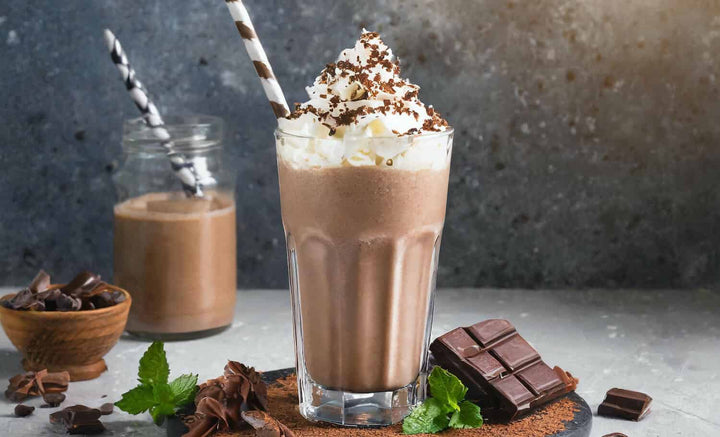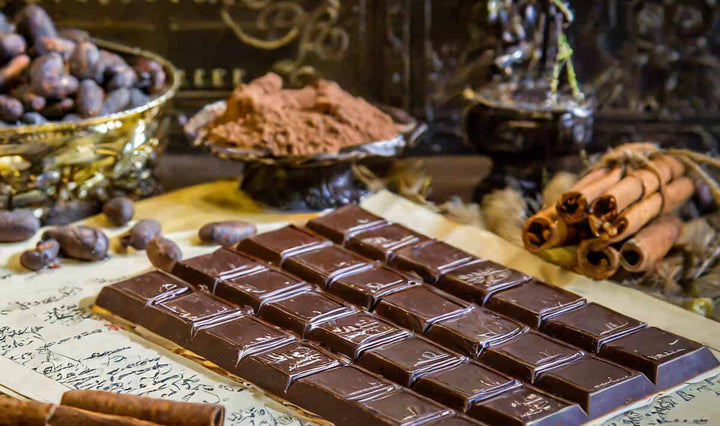Among the variety of chocolates, milk chocolate holds a particularly special place, revered for its creamy texture and sublime balance of sweetness.
But have you ever paused to think - what exactly is milk chocolate?
What makes it different from other types of chocolate, and how is it made?
In this post, we will unwrap the world of milk chocolate, revealing its ingredients, production process, and the secret behind its enduring appeal.
What Is Milk Chocolate?
Milk chocolate is a variety of chocolate that contains cocoa solids, cocoa butter or other fat, sugar, and milk or milk powder.
It has a lighter colour and a sweeter, creamier taste compared to dark chocolate, thanks to the added milk content.
The proportion of these ingredients can vary, but to be labelled as 'milk chocolate' in the UK, it must contain a minimum of 25% cocoa solids.
It's widely enjoyed as a sweet treat in various forms, including chocolate bars, truffles, and in baking recipes.
Related Post: Chocolate Conching?
What Is Milk Chocolate Made Of?
Milk chocolate is made from a few key ingredients, each contributing to its characteristic sweet, creamy flavour and smooth texture. Here's what goes into it:
-
Cocoa Solids: These are the particles left after cocoa butter is extracted from cacao beans. Cocoa solids provide the primary flavour of the chocolate. In the UK, to be classified as 'milk chocolate', a product must contain at least 25% cocoa solids.
-
Cocoa Butter: This is the fat component extracted from cacao beans. Cocoa butter is responsible for the rich mouthfeel and glossy appearance of the chocolate.
-
Milk: Milk, in the form of liquid milk, milk powder, or condensed milk, gives milk chocolate its creamy, smooth texture and mild flavour that balances the intensity of the cocoa.
-
Sugar: Sugar adds sweetness to counter the natural bitterness of cocoa. The amount can vary depending on the desired sweetness of the final product.
-
Lecithin: Often, an emulsifier such as lecithin is used to ensure a smooth, homogeneous mixture of cocoa, cocoa butter, and milk.
-
Flavourings: Additional flavours, like vanilla, may be added to enhance the taste of the chocolate.
The process of making milk chocolate involves blending these ingredients, followed by a process called conching (where the mixture is continuously ground and heated), and then tempering (a careful process of cooling and reheating) to achieve the desired taste and texture.
It's a careful art that, when done right, results in the delectably smooth and creamy treat we all love.
Related Post: What Nutrients Are in Chocolate?
What Percentage Is Milk Chocolate?
The term "percentage" in chocolate refers to the total cocoa content (cocoa solids and cocoa butter) present in the product.
For milk chocolate, UK and European Union regulations stipulate that it must contain a minimum of 25% total cocoa content.
This is less than dark chocolate, which often ranges from 60% to over 90% cocoa content.
However, the specific percentage can vary from product to product.
Higher-quality milk chocolates often have a higher cocoa content, sometimes up to 40% or more, which provides a deeper, more complex chocolate flavour while maintaining the characteristic sweetness and creaminess of milk chocolate.
It's always a good idea to check the label on your chocolate product, as it will typically state the percentage of total cocoa content, giving you a good indication of the flavour intensity you can expect.
Related Post: Types of Chocolate.
How is Milk Chocolate Made?
The process of making milk chocolate is a delicate and precise art. Here are the main steps involved:
-
Harvesting: The process begins with the harvesting of cacao pods from the Theobroma cacao tree. The pods are opened to retrieve the cacao beans.
-
Fermentation: The beans are then fermented, usually in bins or piles covered with banana leaves, for several days. This step is crucial for developing the beans' characteristic chocolate flavour.
-
Drying and Cleaning: After fermentation, the beans are dried and cleaned to remove any remaining pulp.
-
Roasting: The beans are roasted to further develop the chocolate flavour. The roasting temperature and time will affect the final flavour of the chocolate.
-
Cracking and Winnowing: The roasted beans are cracked and the shell is removed, a process known as winnowing. The remaining part, the 'nib', is what is used to make chocolate.
-
Grinding: The nibs are ground into a paste called chocolate liquor. Despite the name, this contains no alcohol. This liquor is composed of cocoa solids and cocoa butter.
-
Blending: The chocolate liquor is then blended with additional cocoa butter, sugar, milk or milk powder, and sometimes vanilla and lecithin. This forms a thick, rough mixture.
-
Conching: This mixture then goes through a process called conching, where it's continuously ground and heated. This can take anywhere from a few hours to a few days. Conching reduces the size of the cocoa particles and blends the ingredients more thoroughly, resulting in smoother chocolate.
-
Tempering: The chocolate is then carefully cooled and then reheated in a process known as tempering. This step is crucial for giving the finished chocolate a shiny appearance and a good 'snap' when broken.
-
Moulding: Finally, the tempered chocolate is poured into moulds and cooled to solidify. After it's set, it can be de-moulded and packaged.
Each stage of the process has an impact on the final flavour and quality of the chocolate.
The specific methods and timings can vary between manufacturers and are often closely guarded secrets, contributing to the unique taste and texture of each brand's chocolate.
Related Post: What is Cocoa?
Where Can You Buy Tasty Milk Chocolate?
If you’re on the hunt for delicious and high-quality chocolate, look no further than Whitakers Chocolates.
With a rich heritage stretching back over 130 years, Whitakers is a name synonymous with excellence in chocolate-making in the UK.
What sets Whitakers apart is our secret family recipe, honed to perfection over generations, and our uncompromising commitment to using only the finest and most natural ingredients.
The result is a range of chocolates that not only taste exquisite but are also crafted with great care and attention to detail.
A significant aspect of Whitakers Chocolates is our ethical approach to production.
We fervently promote the use of Fairtrade Cocoa across our range, ensuring that our delicious chocolates also contribute to sustainable development and fair treatment of cocoa farmers.
Adding to our commendable practices, all Whitakers dark chocolate products have secured Vegan certification.
This means that everyone, regardless of dietary preferences or requirements, can savour their quality dark chocolates without compromise.
So, whether you’re a discerning chocolate lover, a keen follower of a vegan lifestyle, or simply someone who appreciates fine food produced ethically, Whitakers Chocolates is a brilliant choice.
Our legacy of quality and commitment to doing the right thing makes us a standout option for anyone looking to enjoy truly excellent dark chocolate.
Here are a couple of our favourite chocolate choices:
- Milk chocolate & orange chocolate mint wafer thins
- Milk chocolate 90g bar infused with natural sea salt and smoky caramel flavour
- Smooth milk chocolate red foiled hearts
- Milk mint chocolate and honeycomb crisps
Some Notes From an Expert Chocolatier
As an expert chocolatier at Whitakers Chocolates, I have had the pleasure of seeing the magical transformation from cocoa bean to chocolate bar countless times.
Over our century-long history, we've honed our craft to ensure that every bite of our chocolate encapsulates the rich heritage of our brand.
A critical aspect of our approach is a steadfast commitment to quality.
We know that the best chocolates can only be made with the best ingredients, which is why we choose to use only high-quality, natural components in our recipes.
The heart of milk chocolate, the cocoa, is of special significance.
We understand that the choice of cocoa has profound implications, not just for the taste of our chocolates but also for the wellbeing of the communities who grow and harvest the beans.
This understanding has led us to make a significant commitment to using Fairtrade cocoa in our products.
By choosing Fairtrade, we're supporting better working conditions, fair prices, and sustainable practices in cocoa farming communities.
This means that when you enjoy a piece of Whitakers milk chocolate, it's a treat that you can feel good about.
In addition to this, we are proud to cater to a range of dietary requirements.
We offer a selection of gluten-free and vegan chocolates, ensuring that everyone can find something to enjoy in our range.
This commitment to inclusivity reflects our belief that everyone deserves to experience the joy of high-quality chocolate.
At Whitakers, making chocolate is not just about crafting a delicious product. It's about preserving tradition, supporting sustainability and fairness, and sharing the joy of chocolate with as many people as we can.
We encourage everyone to choose high-quality, sustainable chocolates – not only are they a more ethical choice, but we believe they offer a superior taste experience as well. The choice really is as clear as cocoa.
Final Notes On Milk Chocolate
Milk chocolate is a delicacy loved by many for its smooth texture and the perfect balance of sweetness and cocoa flavour.
Comprised of cocoa solids, cocoa butter, sugar, and milk, milk chocolate is a versatile treat enjoyed in a variety of forms worldwide.
But beyond its delicious taste, there's a complex and fascinating process behind each bar of milk chocolate.
From the careful harvesting and fermentation of cacao beans, to the meticulous blending, conching, and tempering processes, the creation of milk chocolate is a craft that requires skill, precision, and a deep understanding of the ingredients.
So, the next time you indulge in a piece of milk chocolate, take a moment to appreciate the journey it's been on.
From the cacao tree to your taste buds, it's a journey marked by care, craft, and a whole lot of love for chocolate.











